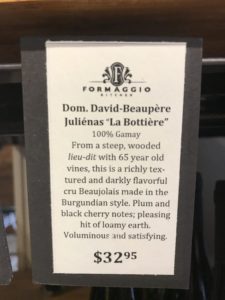 My passport says I’m 3 inches high and two inches and a bit across the middle, but as a practical matter, I’m even smaller. That’s because I require margins top and bottom and on each side, leaving me very little room indeed to do the work I’m paid for: standing in for a human explainer when the question “What kind of wine is this?” is popped – or even just thought of – by a consumer.
My passport says I’m 3 inches high and two inches and a bit across the middle, but as a practical matter, I’m even smaller. That’s because I require margins top and bottom and on each side, leaving me very little room indeed to do the work I’m paid for: standing in for a human explainer when the question “What kind of wine is this?” is popped – or even just thought of – by a consumer.
It’s a shelf talker’s job to deliver information that gets to the nub of what a wine is and how it’s likely to perform in the glass. There’s less agreement about how this is properly done than you might think, and keeping up with changing expectations does keep a shelf talker on its toes.
Though it seems perfectly natural at this point in time, defining a wine by its constituent grape varietals is a relatively recent phenomenon. The likely reason it took so long: the wine industry’s deep, historic aversion to transparency. For centuries wine was distributed via brokers whose business it was to blend stocks of wine into saleable condition while completely obscuring the process by which they accomplished this. (You didn’t hear it from me.)
In the old days, tavern keepers and householders would order Hermitage, or Medoc, or Nuits Saint-Georges and Lord knows what would actually be in that barrel or bottle. It was very unlikely that end-users knew much about how the wine was made or who made it, or, if they did, that they would have considered such information very important. More likely they identified wine simply by its brand name — the Pommeroy’s Ordinary Claret of John Mortimer’s Rumpole stories, is a good example (a wine, by the way, I have always longed to attach myself to). Then, a talker’s task was pretty simple; Say little, give nothing away. So easy.
Today is a different kettle of Cabernet. A reader’s thirst for information about the wine he or she may or may not decide to drink tonight borders on insatiable. Constituent grape varieties – of course. Vintage and appellation – a must. A few words on scent and flavor – naturally. But it hardly stops there. Is this wine made with organic fruit and biodynamic practices? Are the vineyard soils volcanic or alluvial? Is the winemaker an aging hippie or a young Turk (or maybe Turkess)? Providing the most basic data (estate, appellation, vintage, fruit source) exhausts half my space. There’s only so much you can do in the way of a condensed font and ever more minuscule type. It’s the shelf-talker’s private heartbreak that some important information is always left out.
We shelf talkers like to think that giving a reasonably adequate answer to the question “What kind of wine is this?” in such narrow confines is a literary genre in its own right, but it would be wrong to suggest we’re hungry for the kind of critical recognition accorded greeting cards and fortune cookie inserts.
We don’t seek celebrity – just an acknowledgment that every once in a while, against all odds and in 50 words or less, we get it (more or less) right.
Taste, talk and learn about wine this week in the FKC wine corner . . .
THURSDAY, AUGUST 29 3-6 PM – 50 WORDS OR LESS
2016 Di Filippo, Colli Martani Grechetto, $16.95
2018 Tête, “Les Têtes” Touraine Rosé, $17.95
2016 Domaine Illaria, Irouleguy Rouge, $26.95
FRIDAY, AUGUST 30 3-6 PM – POPPING THE QUESTION
2017 Marco Sara, Friuli-Venezia Giulia Verduzzo, $21.95
2018 Mas de Cynanque, Saint Chinian “Rosé de Cynanque,” $17.95
2014 Sikelè, Terre Siciliane Nero d’Avola, $19.95